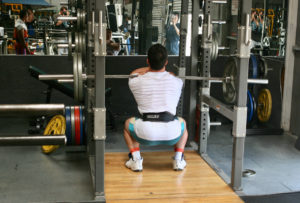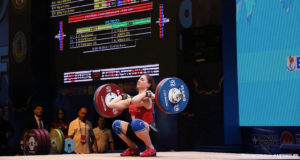
A closer look at this valuable but often neglected exercise
Strength Sensei CP
The back squat is universally accepted as the single best exercise for total body strength and has justifiably earned the title “The King of Exercises.” However, when my colleagues ask me the best way to assess an athlete’s lower body strength, my answer is the front squat. Here are five reasons:
- It positively affects the force-velocity curve.The force-velocity curve is represented by a graph showing an inverse relationship between force and speed. A power snatch will assess the velocity side of a force-velocity curve; the front squat will assess the force side.
- It is the most honest test for lower body strength.Because it is easier to cheat in the back squat than in the front squat, the front squat provides a more objective interpretation of maximal strength levels. If you cheat on the front squat, such as shooting the hips back during the concentric contraction, you will most likely drop the bar. For low-skilled lifters, dropping the bar increases the risk of injury; thus, the incentive to be honest is higher in the front squat.
- It will immediately access your flexibility.You cannot perform the front squat properly unless your flexibility is superior in all the major joints. When you give a strength test that requires flexibility, your athletes have a strong incentive to train for flexibility. This is not the case when performing the back squat, but it is particularly true for bench press addicts who tend to have problems supporting the bar in the correct position on the clavicles. If an athlete has tight forearms and external rotators of the shoulder, it will be challenging to hold the bar during a front squat. This deficiency can be corrected by learning proper technique from an experienced weightlifting coach.
- Sports science research supports its effectiveness.EMG data suggest that the front squat is more effective than the back squat for activating the vastus lateralis and the rectus femoris, two quadriceps muscles. Also, biomechanical analysis suggests that the front squat places less compressive forces on the knee, working the quads harder than the back squat with less stress on the knees.
 The front squat approximates the same position as the catch position of the clean, making it an essential exercise for weightlifters. (This photo by Tim Scott, LiftingLife.com; lead photo by Miloš Šarčev photo)
The front squat approximates the same position as the catch position of the clean, making it an essential exercise for weightlifters. (This photo by Tim Scott, LiftingLife.com; lead photo by Miloš Šarčev photo)
- It is a favorite among strength coaches worldwide.In a survey of top European coaches who were asked to name their three favorite strength exercises, the consensus was the power snatch, the incline bench press, and the front squat.
When comparing the front squat to the back squat, weightlifting coaches believe the front squat has more transfer to the clean (and the power clean). This makes sense. The starting position of a front squat more closely approximates the start position of a clean because the trunk is more upright than in the back squat. The back squat would be considered more specific to the start position of a snatch, as the wider grip forces the athlete to start with a back angle more parallel to the floor. And for a competitive weightlifter, the front squat will obviously help in recovering from the bottom “rack” position of the clean. As such, if an athlete’s power clean or clean is relatively weak compared to other strength tests, it would be appropriate for that athlete to focus more on the front squat.
What is considered a good result in the front squat? I’ve read that top super heavyweight weightlifters such as Paul Anderson, Vladimir Marchuk, Alexander Kurlovich, and Mark Henry front squatted at least 317.5 kilos (700 pounds!), and absolute clean and jerk world record holder Leonid Taranenko did three reps with 300 kilos (661 pounds). Two other weightlifters who deserve mention are three-time Olympic champion Pyrros Dimas of Greece and Dursun Sevinc of Turkey; both weighed 85 kilos (187 pounds) and lifted more than 272 kilos (600 pounds) in the front squat.
If you want to take your strength and athletic ability to a higher level, add front squats to your strength training toolbox!
